For centuries, concert halls have been the cultural heart of a city. Here are 20 of the most unforgettable concert hall experiences around the world, for classical music and beyond.
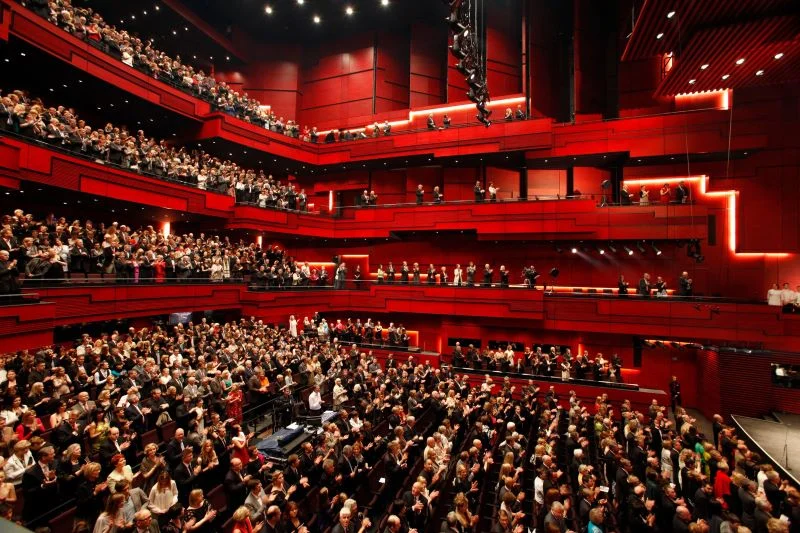
Harpa’s Eldborg Hall, Reykjavík (Photo courtesy of Harpa Hall)
A concert hall unites the grandest architecture with state-of-the-art sound design to accomplish its mission: uplift and inspire citizens and visitors through the power of live performance. The most passionate musicophiles are prepared to travel to see their idols on stage, regardless of the city. Others might make a pilgrimage to a fabled hall, content to hear whoever is up in lights that night. Some cities are blessed with historic classical music venues that have basked in the glory of the most brilliant virtuosi of all time – attending a concert in one of these halls can be a religious experience for some, a bucket-list night out for many.
TravelMag’s carefully curated list of top concert halls around the world is based on venues both centuries-old and brand new, always designed primarily for symphonic music. (Theaters designed for staged opera have their own special allure and history, warranting a separate list. Many arts centers feature spaces for both.) Concert halls seat between 1400 and 5000 music lovers — anything smaller may be classified as a recital hall for solo and chamber musicians. The architecture of these buildings is often a symphony in its own right, whether it has stood the test of time or represents innovation of recent years. And of course, architects work with acoustic designers to ensure the hall sounds as good as it looks, striking the right balance between clarity, reverberance, richness, warmth, and other factors.
TravelMag has also taken into account the quality and diversity of events: a concert hall is only as iconic as the local and international artists that grace the stage. Few of these spaces are reserved exclusively for classical music today, and the programming should be as dynamic and robust as the building itself. Finally, TravelMag considered the impact and prestige of each venue within a city’s cultural landscape. Once ensconced in the plush velvet seat, you may experience the show as a profound revelation. Or you might nod off before the end of the overture — don’t worry, nobody noticed. Either way, there is something to be said for the concert-going ritual. Whether you glimpse them from afar or feel them reverberate from within, these 20 concert halls (in no particular order) are emblems of the cities in which they were built, and should not be missed when you’re in town.
Elbphilharmonie, Hamburg, Germany
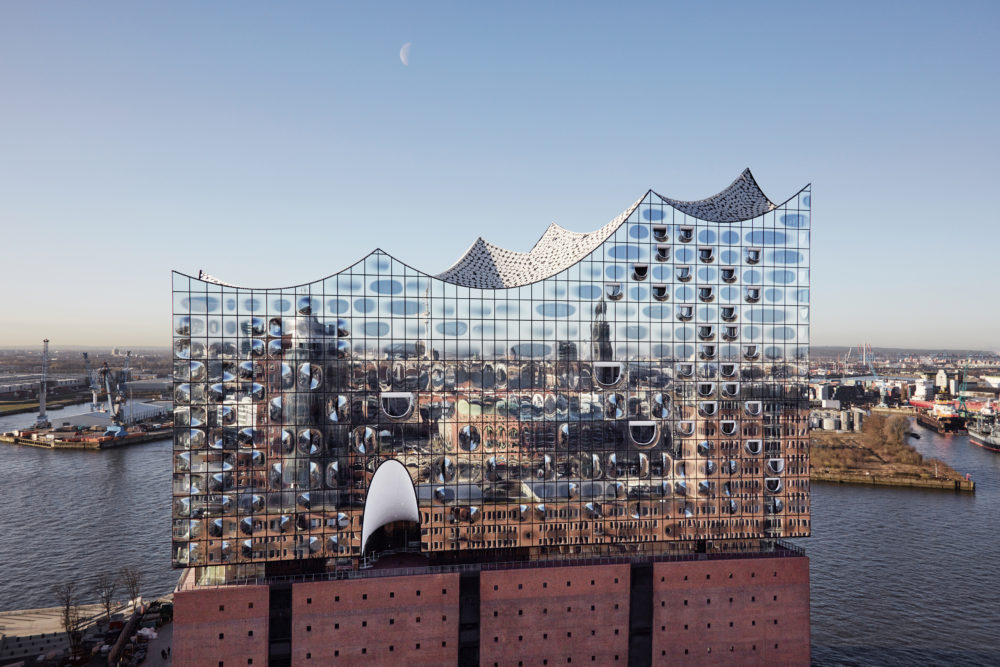
Elbphilharmonie, Hamburg (Photo: Maxim Schulz, courtesy of the Elbphilharmonie)
Inaugurated in January 2017, this towering arts complex has transformed the skyline dramatically, crowning Germany’s second largest city with its wave-like turrets. Soaring to a height of 108 metres (354 ft) in the historic port, the Elbphilharmonie complex is the to date the tallest inhabited building in Hamburg, designed by Swiss firm Herzog & de Meuron. Integrating old and new elements, the mirrored facade of Elphi (as the locals call it) sits atop a 1960s tobacco warehouse, framed on three sides by its namesake, the Elbe River. In collaboration with Nagata Acoustics, the architects settled on a ‘vineyard’ layout of 2,100 seats of the Grosser Saal (large hall), staggering rows so that no one feels too distant from the stage. The smooth oak paneling brings a more intimate ambience than expected in a hall of this size, with wave-like contours sculpted into the wood for an
acoustic that is warm with some cool undercurrents, and unforgivingly precise. You’ll have plenty of time to get excited about a performance when you arrive via the very long (82m / 269-foot) ‘tube’ escalator from street level. It’s comparable to being beamed up into a space ship, only with an orchestra waiting for you at the top.
Concertgebouw, Amsterdam, The Netherlands
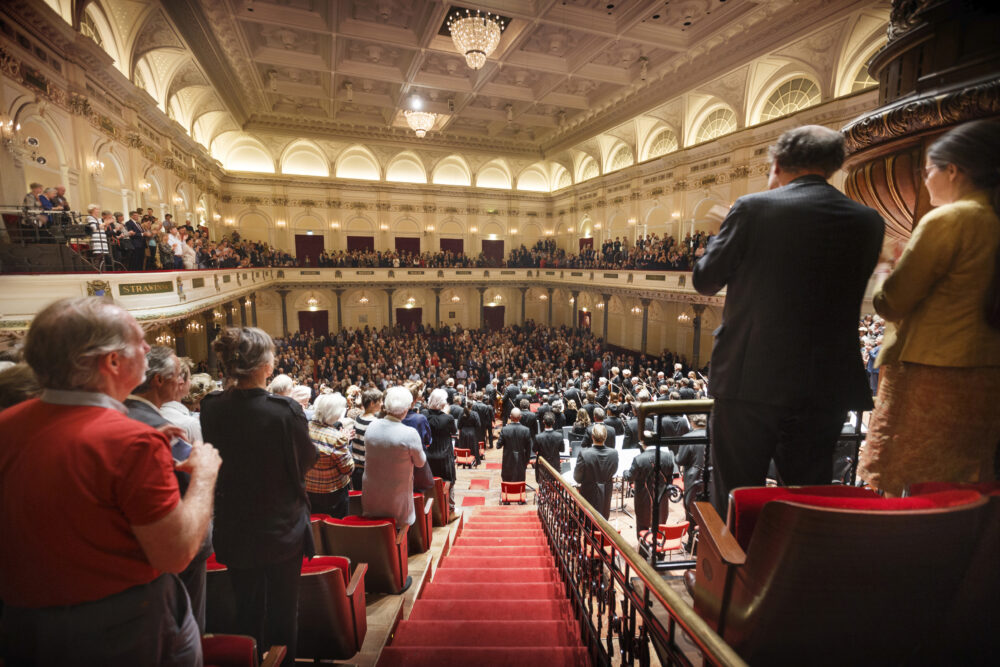
The famous stairs of the Grote Zaal, Amsterdam’s Concertgebouw (Photo: Hans Roggen, courtesy of Het Concertgebouw)
The Koninklijk Concertgebouw (‘the royal concert building’ ) near Amsterdam’s Museumplein is one of the most visited concert halls in the world. Grandiose yet simple in design, it is renowned for both the impeccable acoustics of the Grote Zaal (Main Hall) and the quality of the Royal Concertgebouw Orchestra musicians, who have graced the space since 1886. The hall seats 1,974 in a flat ‘shoebox’ configuration, and its acoustic perfection seems to have been somewhat accidental, since architect Dolf van Gendt was known by family members to be ‘musical as a cow’. Today, the building’s caretakers even allow a thick layer of dust to accumulate on the window frames rather than negatively impacting the acoustic with a wipe-down. With a reverberation time of 2.2 seconds when full, it is ideally suited to late Romantic repertoire, particularly Mahler, who conducted his own Fourth Symphony here in 1904. Pink Floyd was another history-making presence on stage, their 1969 live performance featuring organ later released on disc. The Concertgebouw also boasts the most impressive entryway for any conductor or soloist, down a set of nerve-wracking steep, red-carpeted stairs leading directly to the stage – as perilous as the ones you find in Dutch houses.
Walt Disney Concert Hall, Los Angeles, USA
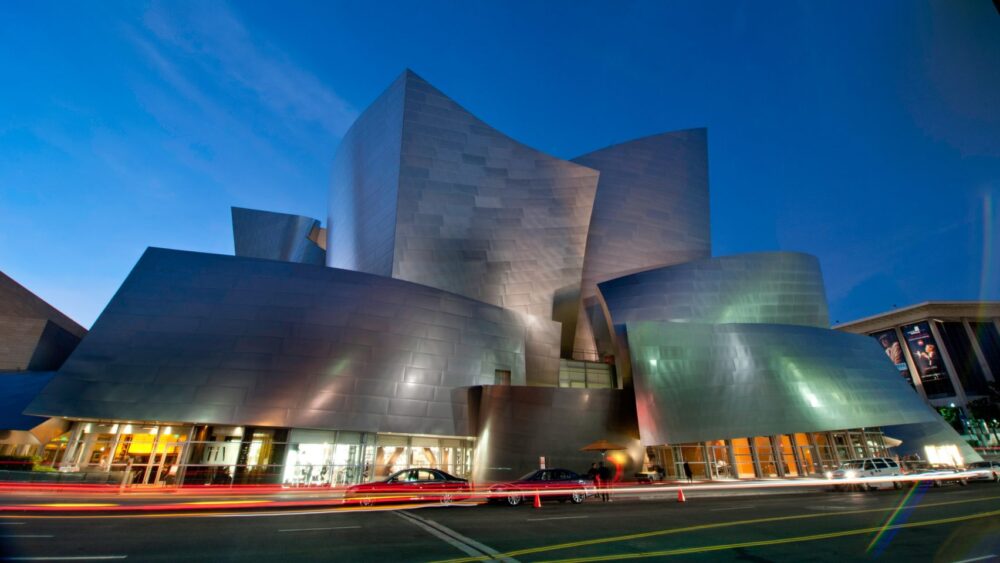
Walt Disney Concert Hall, Los Angeles (Photo courtesy of the Los Angeles Philharmonic Association)
With its sleek yet organic surfaces in stainless steel, the Walt Disney Concert Hall is instantly identifiable as a Frank Gehry creation, although this design predates his work in Bilbao. In little over 20 years, it has reshaped the cityscape of LA. With a capacity of 2,265, the interior is all billowing contours that not only echo the fluid forms of the facade, but serve to enhance sound reflection. Gehry worked closely with acoustician Yasuhisa Toyota (Nagata Acoustics) and former LA Phil music director Esa-Pekka Salonen to ensure that the acoustic is one of great warmth and clarity, thanks to the curved ceiling panelleing in Douglas fir wood, convex shapes, and more than 38,000 reflective faces. A major triumph of the interior is the 50-foot (15-metre) organ, a futuristic forest of 6,134 pipes designed by Gehry himself and organ specialist Manuel Rosales. As the architect proudly affirms: ‘the beauty is in the ear of the beholder’.
Tokyo Opera City Concert Hall, Japan
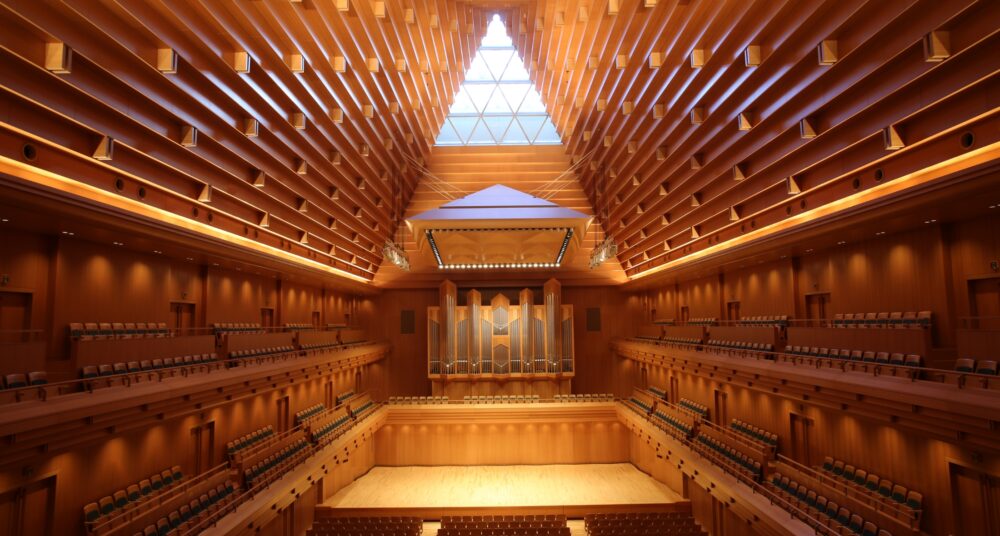
Tokyo Opera City Concert Hall (Photo courtesy of operacity.jp)
In bustling Shinjuku, the 54-floor skyscraper Tokyo Opera City Tower houses a light-filled pyramid of musical perfection, designed by Takahiko Yanagisawa (TAK Architects) and acoustic consultant Dr. Leo Beranek. The Takemitsu Memorial Concert Hall takes its name from the late composer Toru Takemitsu, the instigator of the project who passed away shortly before its completion. This otherwise standard rectangular ‘shoebox’ structure is the world’s first auditorium with a pyramidal vaulted ceiling, as well as the first to feature an interior entirely decked out in oak. Seating an audience of 1,632, it was inaugurated in 1997 with Bach’s St Matthew Passion conducted by Seiji Ozawa, and stars such as Yo-Yo Ma have praised the acoustics. The building is seen destroyed by UFOs in the film Godzilla 2000, but a real-life monster attack seems unlikely, at least in the near future.
Sydney Opera House, Australia
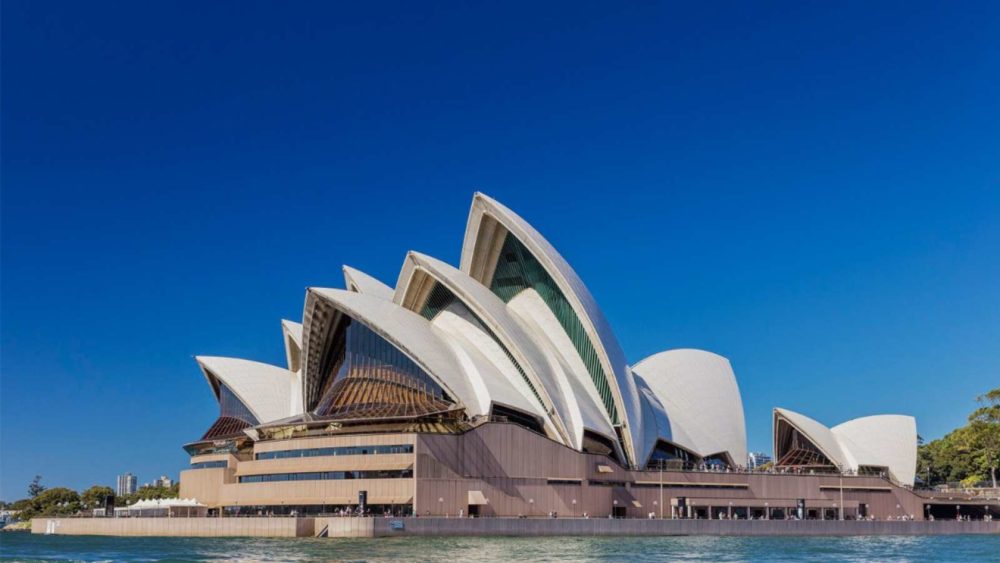
Sydney Opera House (Photo: Hamilton Lund, courtesy of Sydney Opera House)
This is not only one of the greatest concert halls ever imagined, but also one of the most iconic 20th-century structures of any kind. Artists around the world dream of performing in this far-flung white vessel with its sails hoisted over the glittering waters of Sydney Harbour and Circular Quay. And, until recent years, they would have discovered that the interior acoustics were shockingly out of step with the exterior splendor. The Danish architect Jørn Utzon, whose radical design was inspired by birds’ wings, seashells and even a peeled orange, bowed out mid-construction following a dispute with the Australian government in 1966. It took 10 years and AUD$300 million to renovate, a monumental undertaking by ARM Architecture and engineering firm Arup to bring the Sydney Opera House closer to Utzon’s original vision, as well as into the 21st century in terms of accessibility and acoustics. With a capacity of 2,679, the Concert Hall now features 18 petal-shaped fibreglass reflectors to replace the previous hanging ‘donuts’, ensuring a more consistent sound for performers and audience alike. With the makeover completed just in time for its 50th anniversary in 2023, the building on Bennelong Point finally sounds as good as it looks.
Harpa Hall, Iceland
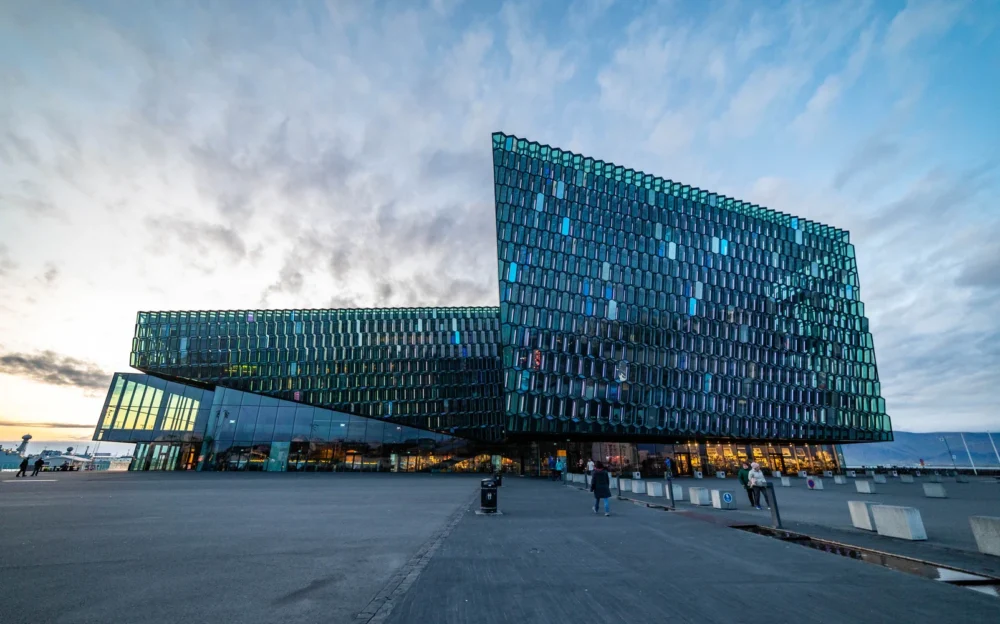
Harpa Hall (Photo courtesy of Harpa Hall)
The world’s northernmost capital of Reykjavík is home to a volcanic music scene, blazing with creative energy. And at its center since 2011 is Harpa, home to the Icelandic Symphony Orchestra. This imposing, angular structure stands proud on the harbor like a newly formed landmass. The whole building shimmers, thanks to the Olafur Eliasson-designed façade and its glass honeycomb matrix that catches, colors and refracts the light in its own Aurora Borealis. The ‘Eldborg’ concert hall (translation: ‘Fire Castle’), meanwhile, smoulders darkly with rich, red birchwood interiors, designed for an adaptable configuration accommodating up to 1,800 spectators. In a city with a population of just 123,000, Harpa has become a pillar of the community; the name (meaning springtime in the old Nordic calendar as well as ‘harp’ in Icelandic) was even chosen from a contest for public suggestions.
Palau de la Música Catalana, Barcelona, Spain
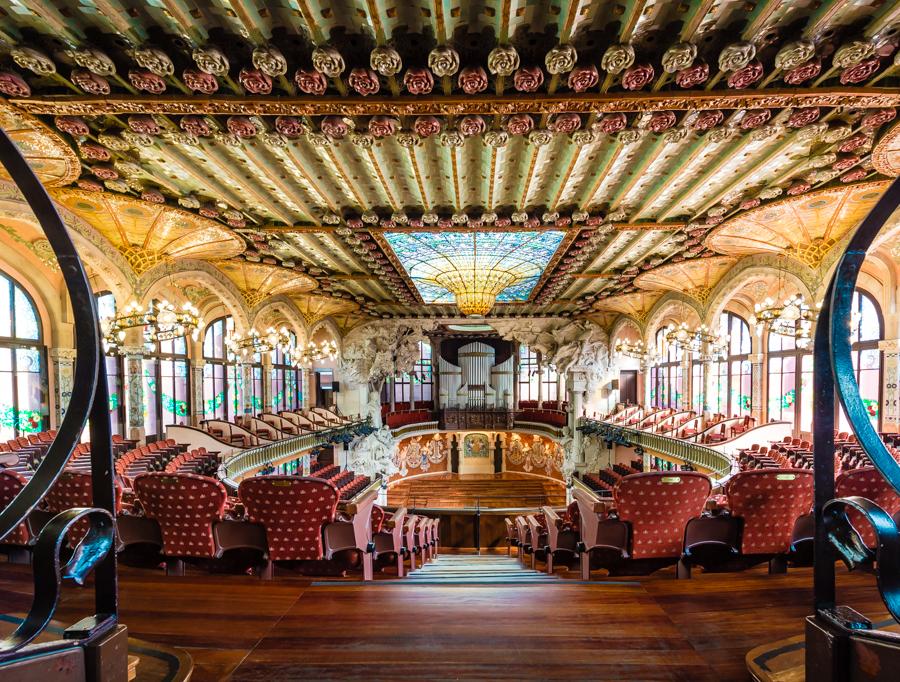
Sala de concerts, Palau de la Música Catalana, Barcelona (Photo: Mateo Vecchi courtesy of the Palau de la Musica)
Named a UNESCO World Heritage Site, the Palau de la Música Catalana is one of the most striking and elegant examples of Catalan Art Nouveau from the turn of the century. It was designed by modernist architect Lluís Domènech i Montaner and completed in 1908 in the chic and arty Sant Pere neighborhood of Barcelona. There are so many intricate details in sculpture, mosaic, and filigree wrought iron, that it’s difficult to know where to look. This opulent sensory experience comes to life when music fills the 2,146-seat Sala de Concerts, an inspiring setting for a symphonic or choral performance beneath the immense stained glass skylight and imposing organ. The architect’s imagination runs wild with muses dancing around the stage, a bust of Beethoven flanked by Valkyries that seem to burst forth from a Doric column, and exuberant colors with decorative flowers and fruits in every sculpted nook and cranny. If you can’t make it to a concert during your visit, a guided tour of the building is the next best thing.
Musikverein, Vienna, Austria
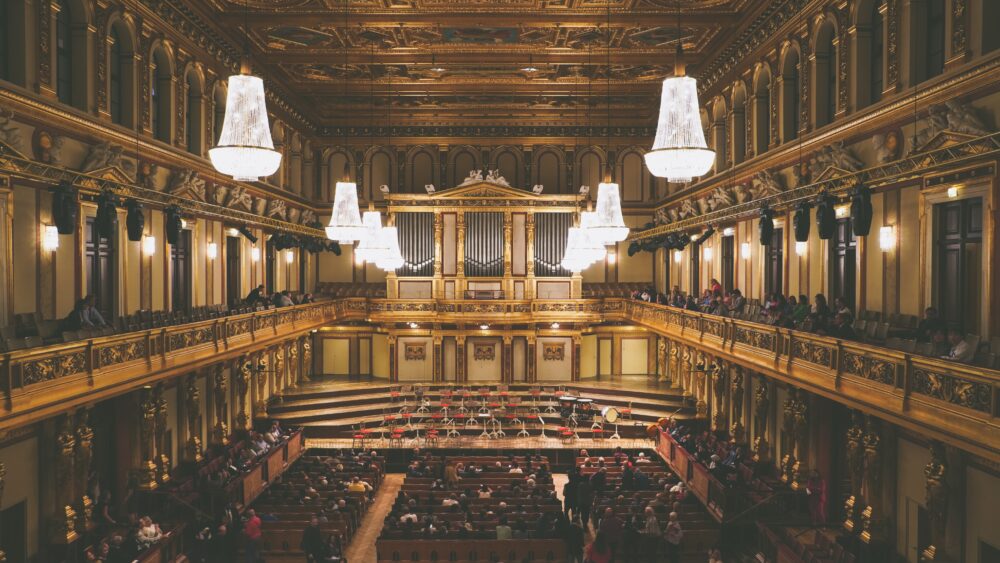
The Musikverein, Vienna (Photo: Jiamin Huang for Unsplashed)
The Haus des Wiener Musikvereins or Vienna Music Society on the Ringstrasse is home to the Vienna Philharmonic, hailed the finest orchestra in the Western Classical tradition by the likes of Richard Wagner and Richard Strauss. Inaugurated in 1870, their hall was designed by Danish architect Theophil Hansen in a neoclassical style inspired by ancient Greek temples. The 1,744-seat Great Hall (also known as the Golden Hall) is famed for its perfect acoustic in the simple design resembling a long, narrow shoebox. Seeing the Wiener Philharmoniker in action on this sacred home ground is a dreamed of extravagance for many classical music afficionados, and no other moment is more sought after than the traditional Vienna New Year’s Concert, held annually since the 1930s and for which the stage is steeped in gardlands of flowers.
Teatro Colón, Argentina
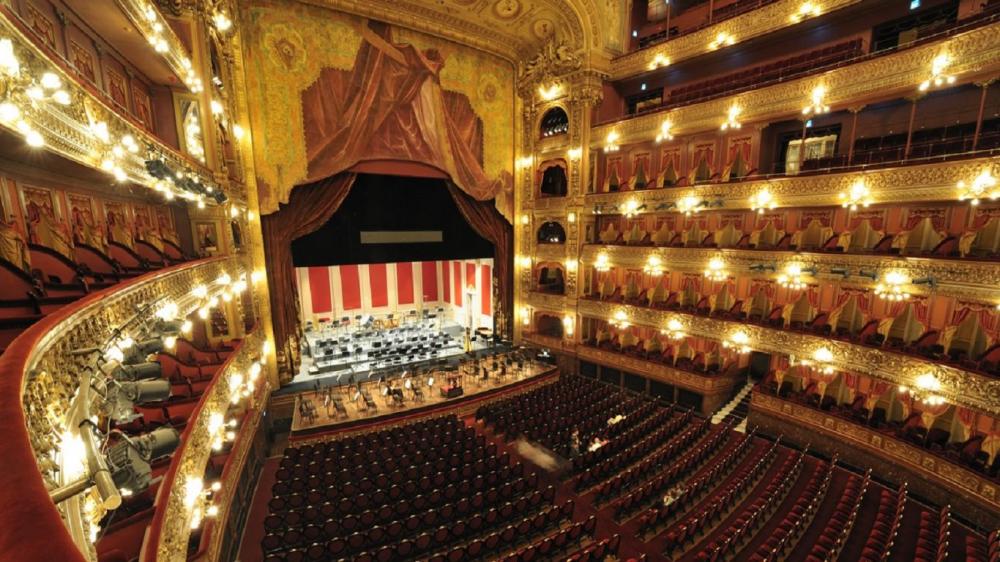
Teatro Colón, Buenos Aires (Photo courtesy of Teatro Colón)
With its sumptuous velvet interiors and gilded proscenium arch, the Teatro Colón in the heart of Buenos Aires is the nation’s most illustrious venue, not only for opera, but also for recitals and ballet. It also happens to be praised by the likes of Pavarotti for the depth of its acoustics. The hall is situated on the Plaza Lavalle, where it reveals its eclectic mix of Italian neorenaissance and neo-Baroque influences, particularly inspired by Paris’ Palais Garnier. Inaugurated in 1908 and seating 2,487, it can be best appreciated in a show of local tango.
Konzerthaus Berlin, Germany
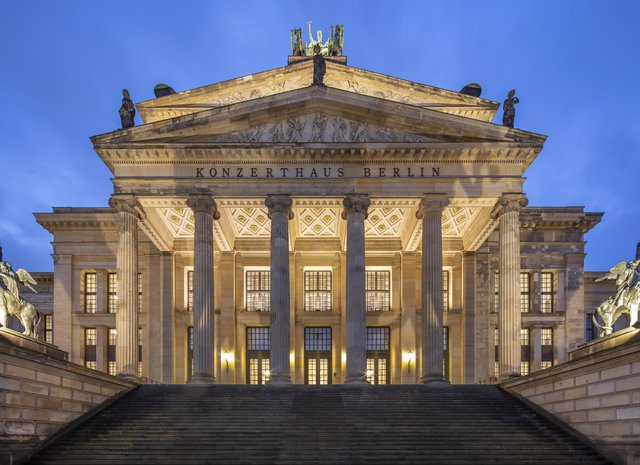
Konzerthausorchester on the Gendarmenmarkt (Photo courtesy of the Konzerthaus Berlin)
Berlin has one of the most impressive condensations of world-class orchestras and concert halls in the world, but the neoclassical Konzerthaus has a special historical status. Originally the Schauspielhaus (play house), bombed in WWII, faithfully rebuilt and renamed as the Konzerthaus Berlin, the Karl Friedrich Schinkel-designed building on the Gendarmenmarkt opened in 1821. Beethoven’s Ninth had its first Berlin performance here, and Bernstein conducted the same work’s ‘Ode to Joy’ on the same stage in 1989 to mark the fall of the Berlin Wall; today it is home to the Konzerthausorchester. Its 1,700-seat Great Hall was completely rebuilt in 2014, but retains the original ornate ceiling decorations with 14 chandeliers, sumptuous red, gold and stucco details, and 38 composers’ busts. Designed in the rectangular ‘shoebox’ configuration, it is revered along with the Musikverein in Vienna and Boston’s Symphony Hall as one of the greatest 19th-century acoustics.
Lucerne Culture and Congress Centre, Switzerland
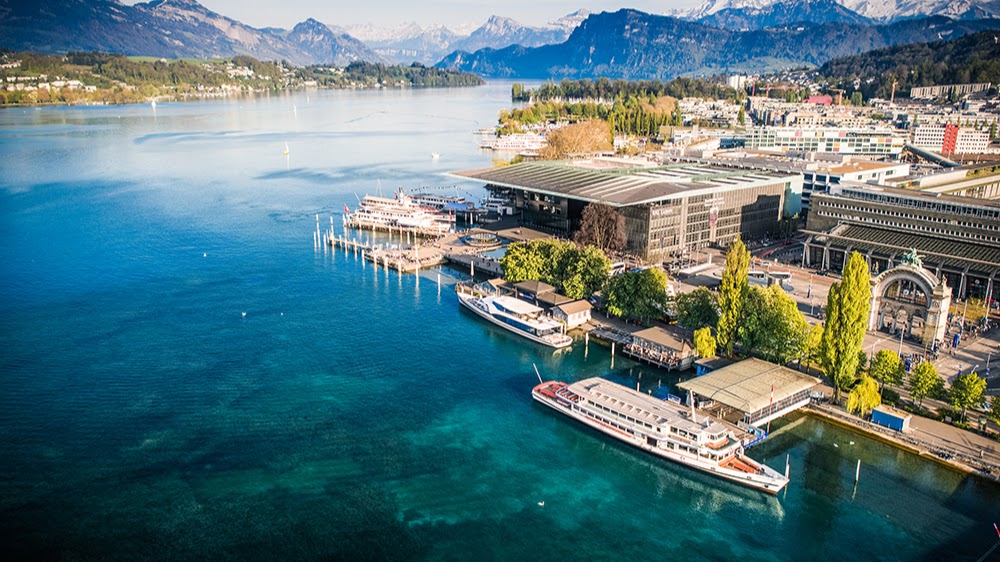
Lucerne Culture and Congress (Photo courtesy of KKL Luzern)
Poised on picturesque Lake Lucerne with a stunning viewing deck over the water, the Lucerne Culture and Congress Centre is situated close to the old town and to the main train station. What the French architect Jean Nouvel originally imagined as a ship of a concert hall floating in the middle of the lake became a building divided into three parts separated by water gardens. The lake’s reflection dances along the slanted copper rooftop as you admire the mountain view from the panoramic terrasse. Nouvel enlisted American acoustician Russell Johnson (Artec) to ensure an optimal sound quality across a diverse range of musical styles. With sleek, creamy textures, the interior in classic shoebox formation seats up to 1,900 to applaud the Lucerne Festival Orchestra and stars such as Cecilia Bartoli, Anne-Sophie Mutter and Martha Argerich.
National Kaohsiung Center for the Arts (Weiwuying), Taiwan
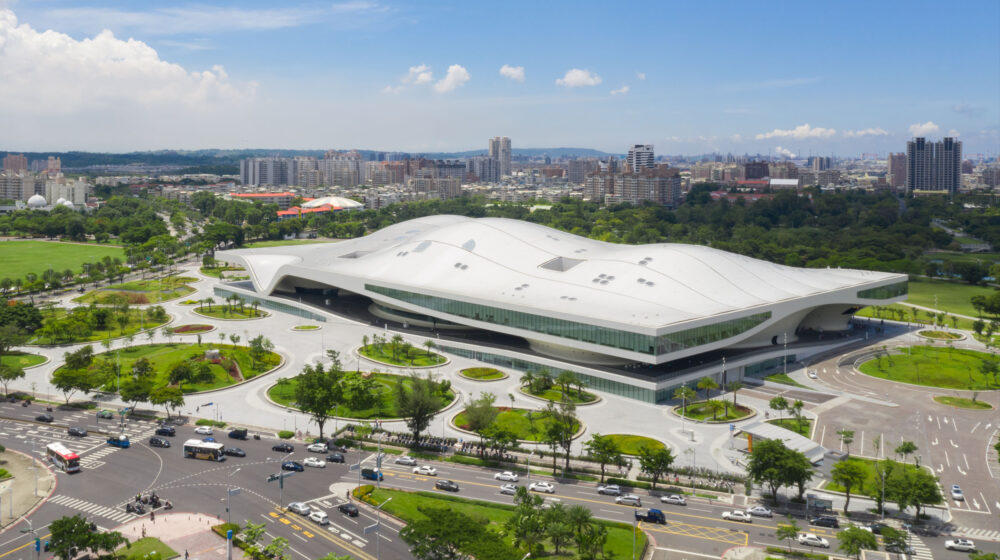
Weiwuyin, Taiwan (photo: Mecanoo Architecten)
Opened in October 2018 on the site of a former military base in the southern port city of Kaohsiung, Weiwuying has been hailed the largest self-contained performing arts center in the world. Spread over 35 acres (14 hectares) of land in the northeast of the Weiwuying Metropolitan Park, Fengshan district, the building designed by Francine Houben and Dutch firm Mecanoo is inspired by the twisting forms of the surrounding banyan trees: a sloping, undulating expanse of white, with unexpected curves and dips leading to an open-air amphitheatre carved into the building itself. The interior concert features 1,981 golden seats, underneath adjustable acoustic shells for quality sound control, and the largest double organ in Asia, with 9,085 pipes in striking asymmetrical formation. Every curve, every surface takes into account feng shui and the circulation of air in Taiwan’s subtropical climate.
Théâtre des Champs-Elysées, Paris, France
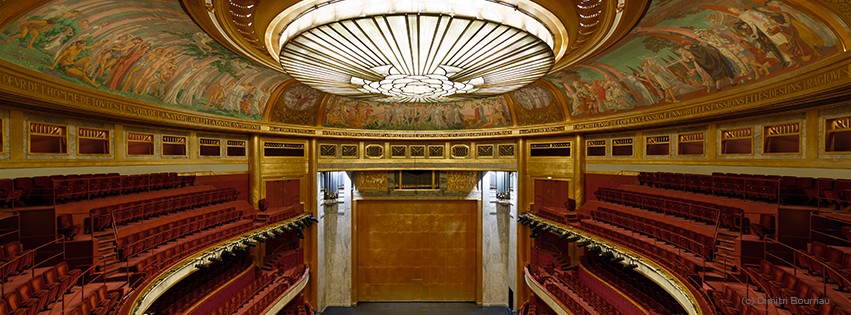
Théâtre des Champs-Elysées (Photo courtesy of the Théâtre des Champs Elysées)
Although Paris has no shortage of sophisticated concert halls, both baroque and modern, not least the Philharmonie inaugurated in 2015, it’s the unique and illustrious history of the Théâtre des Champs-Elysées that stands out. The first and most elegant examples of an Art Deco ediface in the city of light, the building was conceived for orchestral music, recitals and opera, based on designs by brothers Auguste and Gustave Perret, with striking bas-relief sculptures from Antoine Bourdelle. It became something of a succès de scandale in its first season, when the premiere of Stravinsky’s The Rite of Spring provoked a punch-up: top hats flying everywhere. A second controversial evening followed in 1925 when Josephine Baker performed on stage in Paris for the first time, in little more than her famous banana skirt. Today, the Théâtre des Champs-Elysées watches over the glitzy strip of luxury boutiques on Avenue de la Montaigne, so you can enjoy a little window shopping before nestling into one of the 1,905 red velvet seats to admire the luminous gold backdrop and pastel frescoes.
National Centre for the Performing Arts, Beijing, China
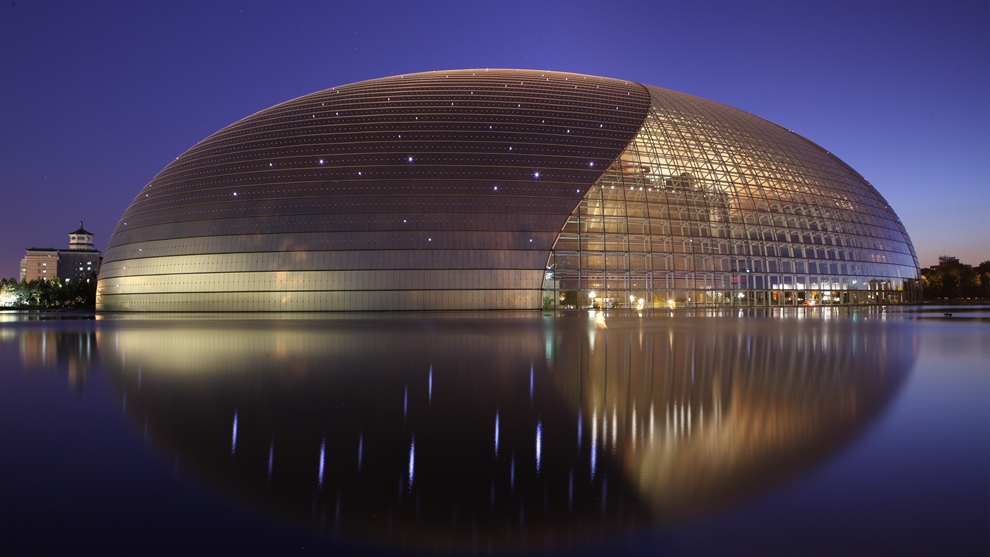
National Centre for the Performing Arts, Beijing (Photo courtesy of chncpa.org)
Completed in 2007 and true to the vision of French architect Paul Andreu, this arts complex in the central Xicheng District of Beijing stands out on the skyline, its distinctive semi-ellipsoidal shape earning it the nickname ‘the giant egg’. The shell-like exterior comprises more than 18,0000 pieces of flexible titanium (of which only four are the same shape) and 1,200 pieces of ultra-white glass, creating an immense surface that resembles a curtain parting. The concert hall can accommodate up to 1,859 spectators, who are likely to marvel at the embossed ceiling, aesthetics-rich but also contributing to an even diffusion of sound. Most impressive is the entrance: extending 10 stories underground, the building is buoyed on an artificial lake, requiring all concert-goers to cross a long underwater passage. In close proximity to Tiananmen Square, the Great Hall of the People and the Forbidden City, the venue’s avant-garde design was initially controversial, but it has become a much-loved addition to the Beijing skyline.
Sala São Paulo, Brazil
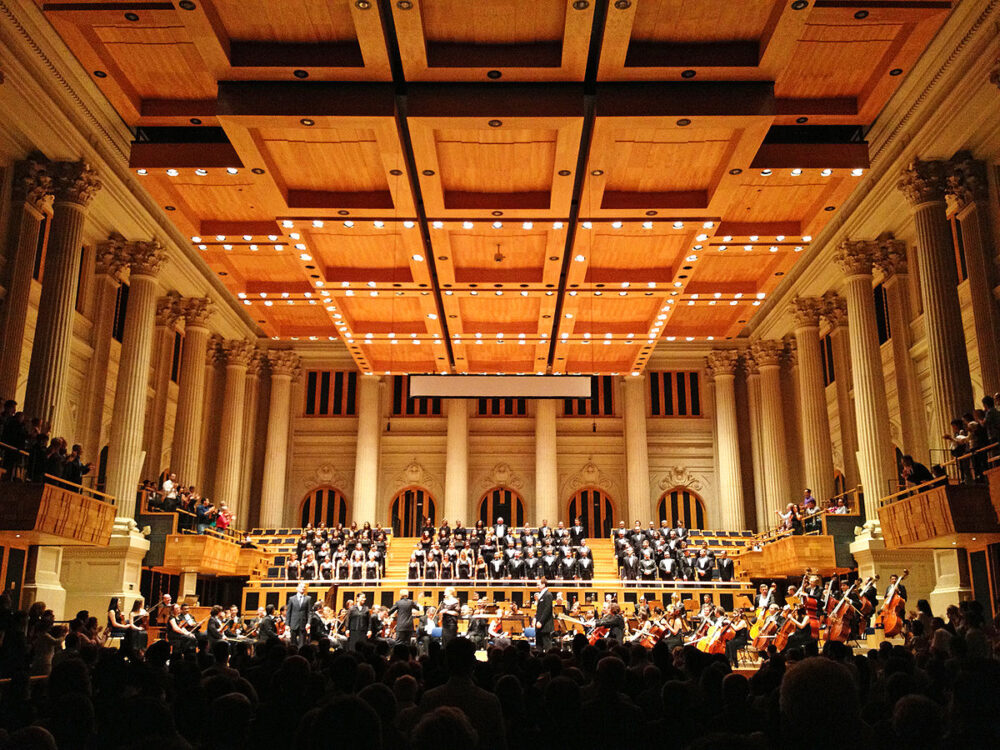
São Paulo State Symphonic Orchestra (Photo by Marcio De Assis for Wikimedia Commons)
There’s something irresistibly poetic about looking at a dilapidated railway station and seeing the potential to transform it into a magnificent concert hall. That’s exactly what happened at the Júlio Prestes Train Station waiting area in north central São Paulo. Someone noticed that the ‘shoebox’ proportions corresponded almost exactly to those of the most glorious sounding concert halls ever built, in Boston, Amsterdam and Vienna. The eclectic mix of neoclassical and Louis XVI-inspired architecture, too, invited a musical makeover, and the repurposed site was baptized the Júlio Prestes Cultural Center in 1999. The original plaza’s columns are still visible, surrounding the 1,498 seats. The rest is a symphony of ingenious architectural and acoustic design to neutralize vibrations from passing trains, as well as adding an adjustable ceiling mechanism built by American company Artec in order to alter the hall’s acoustic properties. It is the long-awaited permanent home of the São Paulo State Symphonic Orchestra, welcoming major international artists and, on one occasion, Elton John.
Great Hall of Moscow Conservatory, Russia
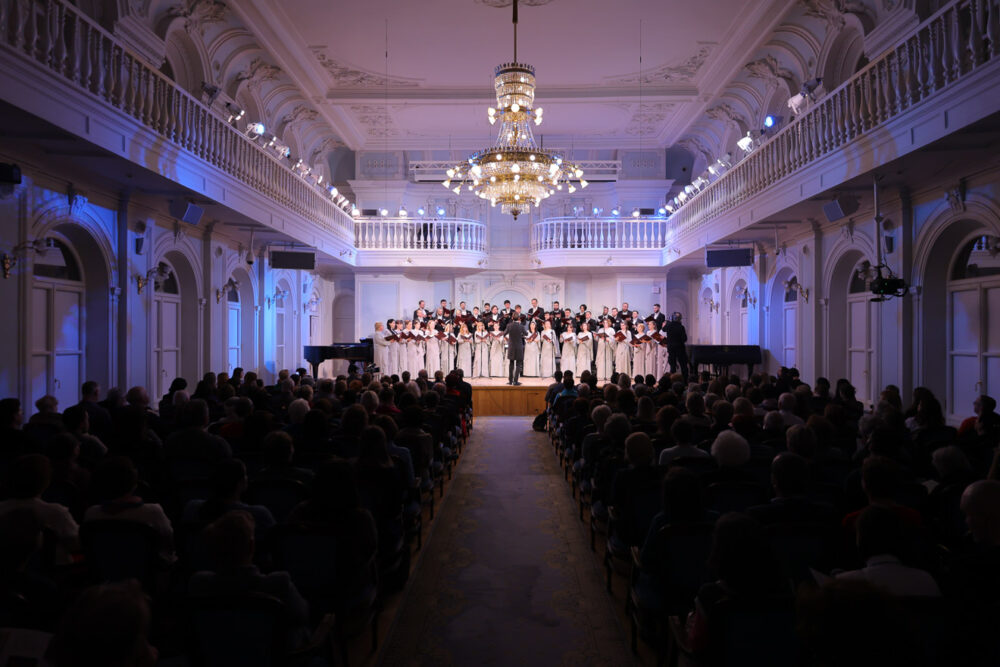
Rachmaninov concert in the Great Hall of the Moscow Conservatory (Photo: Moscow Conservatory)
Although Saint Petersburg’s Bolshoi Theater is the Russian venue that stands out in the imagination, it is the unassuming elegance and classical simplicity of the Great Hall of the Moscow Conservatorium that belie its astonishing acoustics. Inaugurated in 1901, the auditorium itself has been likened to ‘an enormous Stradivarius violin’, thanks to the warmth and clarity of its natural acoustics. Centrally located and with 1,852 seats, the Great Hall presents not only the opportunity to listen to the young up-and-coming classical stars of Russia, but every four years hosts the International Tchaikovsky Competition, named after the great composer and former professor at the Conservatory.
Guangzhou Opera House, China
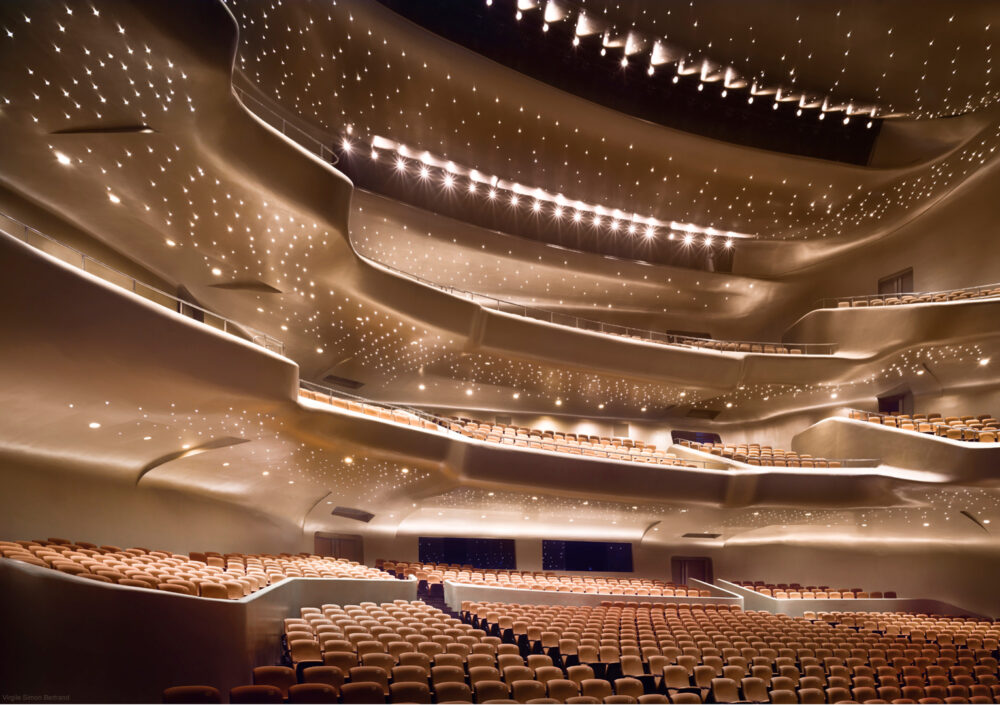
The auditorium of Guangzhou Opera House (Photo courtesy of zaha-hadid.com)
Completed in 2010 to a budget of US$200 million, Guangzhou Opera House and performing arts complex is one of the major triumphs of the late Iraqi-British architect Zaha Hadid (nicknamed ‘queen of the curve’), whose firm is also responsible for the Beethoven Concert Hall in Bonn and the Heydar Aliyev Centre in Baku. Her design is intrinsically linked to the natural surrounds, all fluid contours and a double boulder structure echoing the nearby Pearl River. Hadid’s team worked closely with acousticians from the Melbourne-based Marshall Day firm to ensure that the 1,800-seat auditorium, with its constellation of lights enveloping the audience, caters to both Western and Chinese opera, two artforms with vastly different projection requirements. The building positions China’s most important port city as a major cultural hub.
Rudolfinum, Prague, Czech Republic
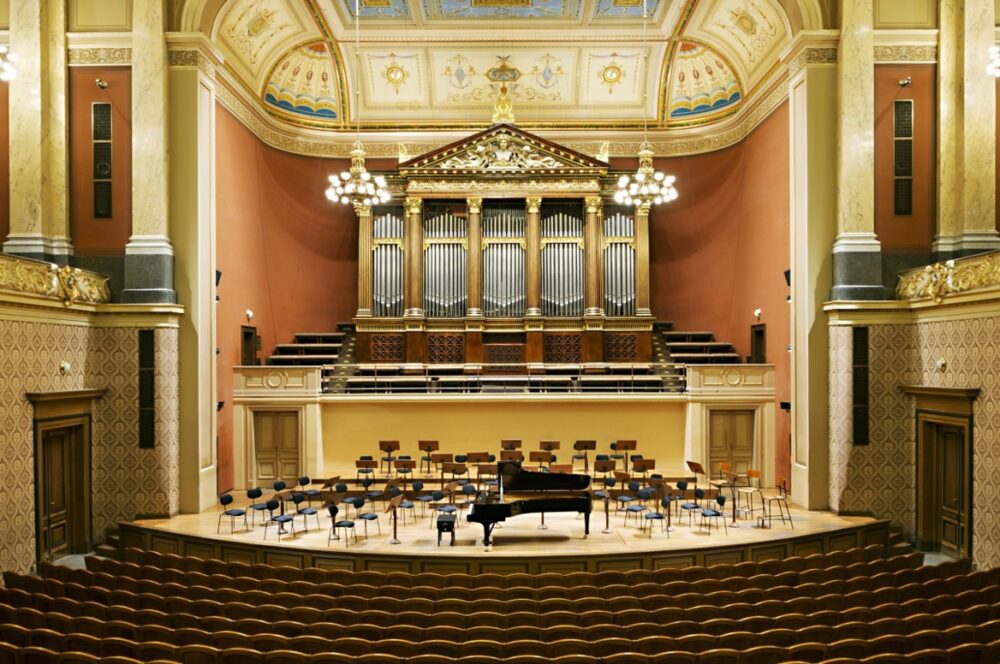
Dvořák Hall (Photo courtesy of the Rudolfinum)
This exquisite Neo-Renaissance building on the banks of the Vltava is a Czech architectural jewel, home to the Czech Philharmonic since 1896. Designed by Josef Zítek and Josef Schulz on the former site of a prison and sawmill, and named after the Crown Prince Rudolf, it was one of the first multi-purpose cultural complexes in history, also housing a gallery and conservatory. The Rudolfinum’s Dvořák Hall is one of the oldest concert halls in Europe. The honor of conducting the inaugural concert was given to the nation’s greatest musical beacon, the composer Antonín Dvořák.
Carnegie Hall, New York, USA
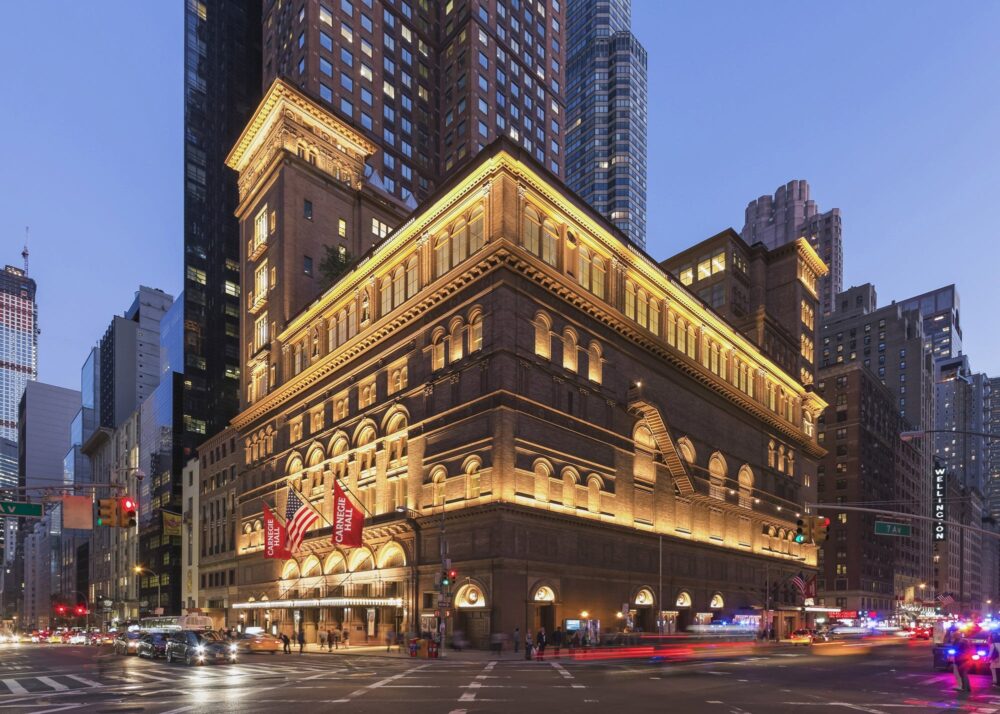
Carnegie Hall lit up at night (Photo courtesy of carnegiehall.org)
No doubt about it: if you’ve performed in Carenegie Hall, your place in cultural history is assured. The Big Apple’s premier concert venue was opened in 1891 in uptown New York close to Central Park, and funded by the wealthy industrialist Andrew Carnegie. The architect was William Burnet Tuthill, an amateur cellist, and the building resembled a six-story brick house with Italian Renaissance details from the outside, with a main hall seating 2,800 on the inside. (The trowel Mrs Carnegie used to lay the first cornerstone was later dipped in silver by Tiffany & Co.) Tchaikovsky conducted at the inaugural concert and the venue has enjoyed a star-studded history ever since, from classical to jazz and pop: Rachmaninov, Maria Callas, Liza Minnelli, Bob Dylan, Billie Holiday and The Beatles.
Royal Albert Hall, London, UK
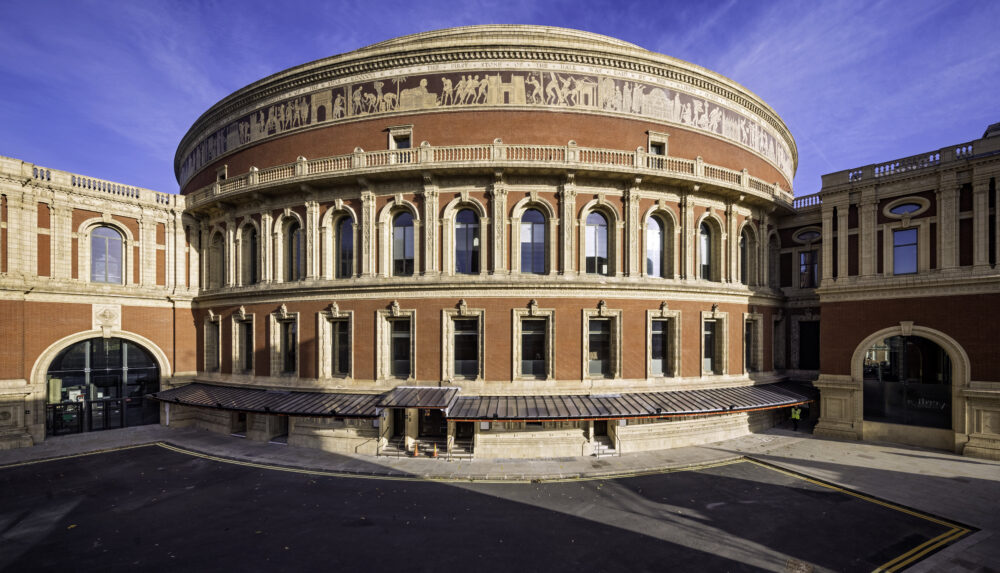
London’s Royal Albert Hall (Photo: David Levene courtesy of Royal Albert Hall)
Summer in London without the Proms would be like taking high tea without scones. The quintessentially British institution of the BBC Promenade Concerts has been an annual fixture at the Royal Albert Hall since 1941, and no concert in that series is more beloved than the Last Night of the Proms, a festive and patriotic event for the masses, in which balloons and Union Jacks take over this vast hall with a capacity of 5,272 (including standing room). Standing opposite Hyde Park in South Kensington, and named after Prince Albert, the consort of Queen Victoria, this imposing red-brick rotunda was completed in 1871, a decade after his death.
For almost 100 years, it was plagued by poor acoustics in the form of an unseemly echo in the rattling around the cavernous ceiling (the 20,000 sq. ft. glazed-iron roof was the largest unsupported dome in the world). Fibreglass acoustic diffusers (affectionately referred to as ‘mushrooms’) now hang from the auditorium ceiling, and in 2017 the hall was decked out with the world’s largest single-room speaker system, bringing intimacy to stadium-like proportions. To see who’s graced the stage, stroll along the Hollywood-style Walk of Fame under the canopy: Eric Clapton, Adèle, and even Muhammad Ali, who fought in the hall three times.